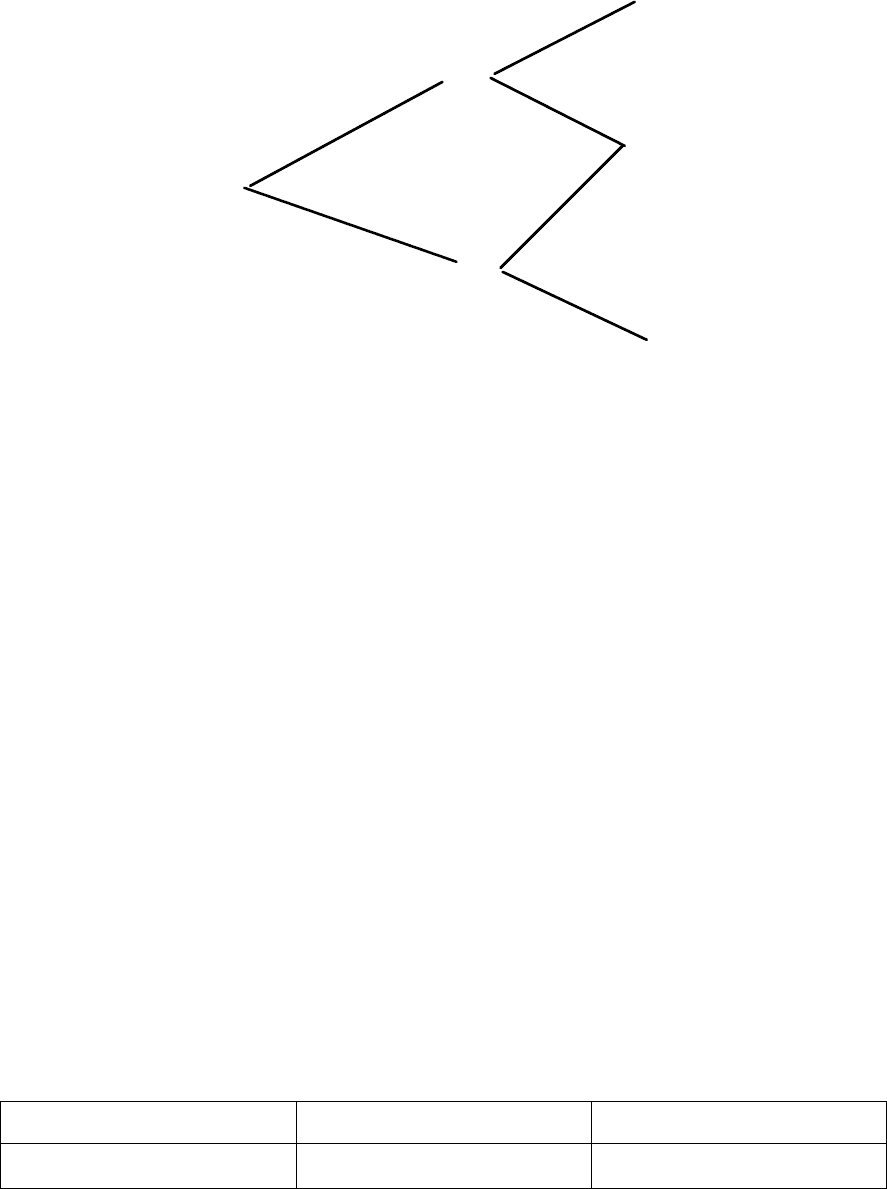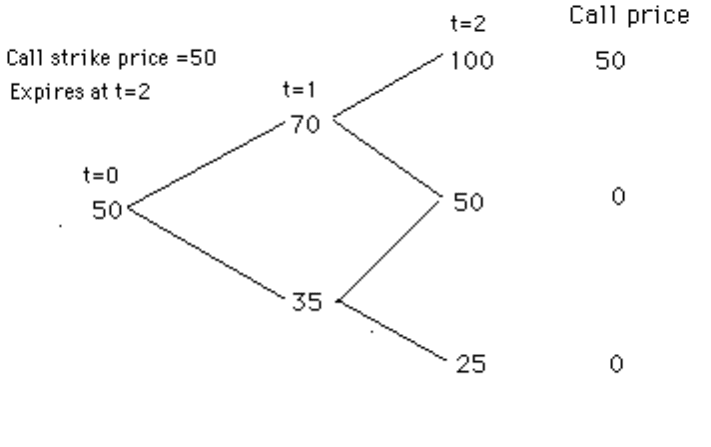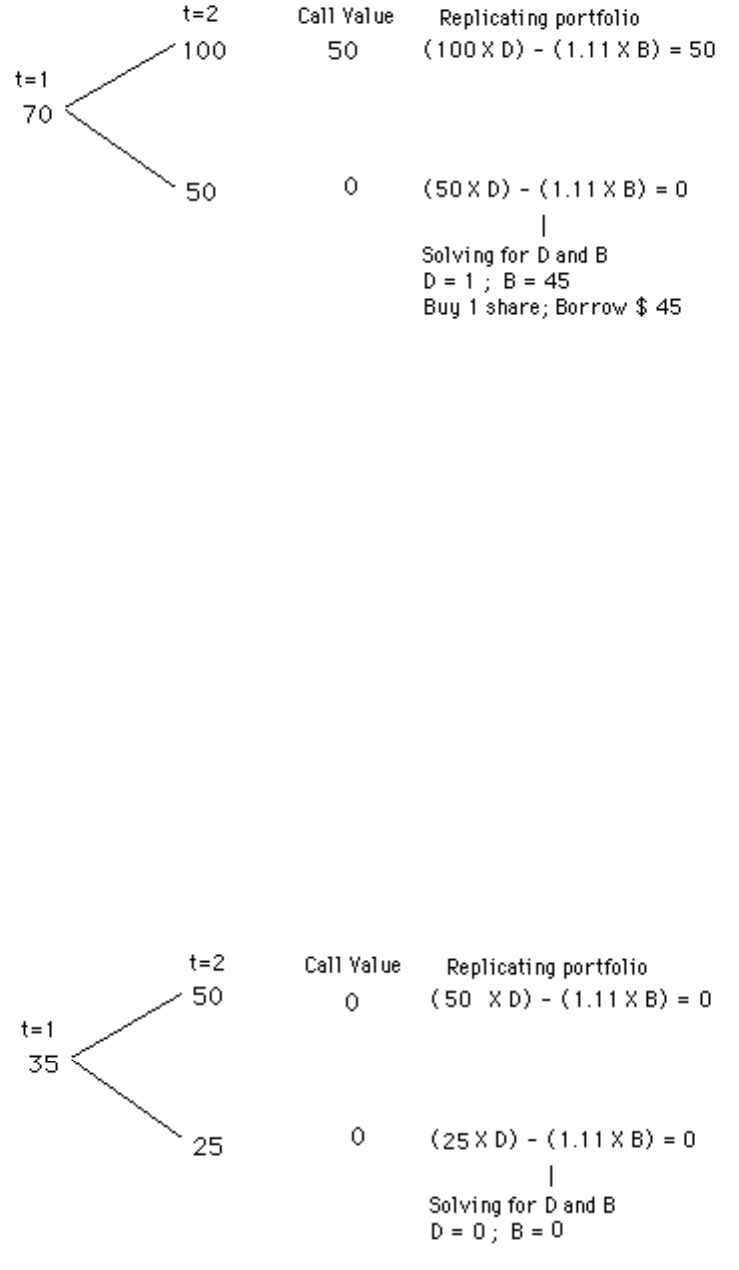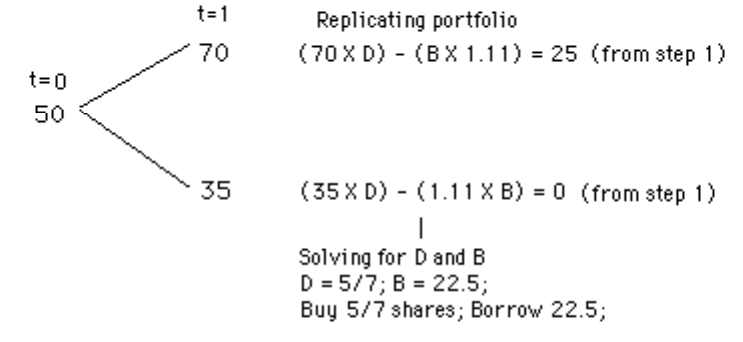Damodaran A. Applied corporate finance
Подождите немного. Документ загружается.


5
5
S
Su
Sd
Su
2
Sd
2
Sud
In this figure, S is the current stock price; the price moves up to Su with probability p and
down to Sd with probability 1-p in any time period. For instance, if the stock price today
is $ 100, u is 1.1 and d is 0.9, the stock price in the next period can either be $ 110 (if u is
the outcome) and $ 90 (if d is the outcome).
Creating A Replicating Portfolio
The objective in creating a replicating portfolio is to use a combination of risk-
free borrowing/lending and the underlying asset to create the same cash flows as the
option being valued. In the case of the general formulation above, where stock prices can
either move up to Su or down to Sd in any time period, the replicating portfolio for a call
with a given strike price will involve borrowing $B and acquiring ∆ of the underlying
asset. Of course, this formulation is of no use if we cannot determine how much we need
to borrow and what Δ is. There is a way, however, of identifying both variables. To do
this, note that the value of this position has to be same as the value of the call no matter
what the stock price does. Let us assume that the value of the call is C
u
if the stock price
goes to Su, and C
d
if the stock price goes down to Sd. If we had borrowed $B and bought
Δ shares of stock with the money, the value of this position under the two scenarios
would have been as follows:
Value of Position
Value of Call
If stock price goes up to Su
Δ Su - $ B (1+r)
C
u

6
6
If stock price goes down to
Sd
Δ Sd - $ B (1+r)
C
d
Note that, in either case, we have to pay back the borrowing with interest. Since the
position has to have the same cash flows as the call, we get
Δ Su - $ B (1+r) = C
u
Δ Sd - $ B (1+r) = C
d
Solving for Δ, we get
∆ = Number of units of the underlying asset bought = (C
u
- C
d
)/(Su - Sd)
where,
C
u
= Value of the call if the stock price is Su
C
d
= Value of the call if the stock price is Sd
When there are multiple periods involved, we have to begin with the last period,
where we know what the cash flows on the call will be, solve for the replicating portfolio
and then estimate how much it would cost us to create this portfolio. We then use this
value as the estimated value of the call and estimate the replicating portfolio in the
previous period. We continue to do this until we get to the present. The replicating
portfolio we obtain for the present can t be priced to yield a current value for the call.
Value of the call = Current value of underlying asset * Option Delta
- Borrowing needed to replicate the option
In Practice 5.12: An Example of Binomial valuation
Assume that the objective is to value a call with a strike price of 50, which is
expected to expire in two time periods, on an underlying asset whose price currently is 50
and is expected to follow a binomial process. Figure 4 illustrates the path of underlying
asset prices and the value of the call (with a strike price of 50) at the expiration.
Figure 4: Binomial Price Path

7
7
Note that since the call has a strike price of $ 50, the gross cash flows at expiration are as
follows:
If the stock price moves to $ 100: Cash flow on call = $ 100 - $ 50 = $ 50
If the stock price moves to $ 50: Cash flow on call = $ 50 - $ 50 = $ 0
If the stock price moves to $ 25: Cash flow on call = $ 0 (Option is not exercised).
Now assume that the interest rate is 11%. In addition, define
Δ = Number of shares in the replicating portfolio
B = Dollars of borrowing in replicating portfolio
The objective, in this analysis, is to combine Δ shares of stock and B dollars of borrowing
to replicate the cash flows from the call with a strike price of $ 50.
The first step in doing this, is to start with the last period and work backwards.
Consider, for instance, one possible outcome at t =1. The stock price has jumped to $ 70,
and is poised to change again, either to $ 100 or $ 50. We know the cash flows on the call
under either scenario, and we also have a replicating portfolio composed of Δ shares of
the underlying stock and $ B of borrowing. Writing out the cash flows on the replicating
portfolio under both scenarios (stock price of $ 100 and $ 50), we get the replicating
portfolios in figure 5:
Figure 5: Replicating Portfolios when Price is $ 70

8
8
In other words, if the stock price is $70 at t=1, borrowing $45 and buying one share of
the stock will give the same cash flows as buying the call. The value of the call at t=1, if
the stock price is $70, should therefore be the cash flow associated with creating this
replicating position and it can be estimated as follows:
70 Δ - B = 70-45 = 25
The cost of creating this position is only $ 25, since $ 45 of the $ 70 is borrowed. This
should also be the price of the call at t=1, if the stock price is $ 70.
Consider now the other possible outcome at t=1, where the stock price is $ 35 and
is poised to jump to either $ 50 or $ 25. Here again, the cash flows on the call can be
estimated, as can the cash flows on the replicating portfolio composed of Δ shares of
stock and $B of borrowing. Figure 6 illustrates the replicating portfolio:
Figure 6: Replicating Portfolio when Price is $ 35

9
9
Since the call is worth nothing, under either scenario, the replicating portfolio also is
empty. The cash flow associated with creating this position is obviously zero, which
becomes the value of the call at t=1, if the stock price is $ 35.
We now have the value of the call under both outcomes at t=1; it is worth $ 25 if
the stock price goes to $ 70 and $0 if it goes to $ 35. We now move back to today (t=0),
and look at the cash flows on the replicating portfolio. Figure 7 summarizes the
replicating portfolios as viewed from today:
Figure 7: Replicating Portfolios for Call Value
Using the same process that we used in the previous step, we find that borrowing $22.5
and buying 5/7 of a share will provide the same cash flows as a call with a strike price of
$50. The cost, to the investor, of borrowing $ 22.5 and buying 5/7 of a share at the
current stock price of $ 50 yields:
Cost of replicating position = 5/7 X $ 50 - $ 22.5 = $ 13.20
This should also be the value of the call.
More on the Determinants of Option Value
The binomial model provides insight into the determinants of option value. The
value of an option is determined not by the expected price of the asset but by its current
price, which, of course, reflects expectations about the future. In fact, the probabilities
that we provided in the description of the binomial process of up and down movements
do not enter the option valuation process, though they do affect the underlying asset’s
value. The reason for this is the fact that options derive their value from other assets,
10
10
which are often traded. Consequently, the capacity investors possess to create positions
that have the same cash flows as the call operates as a powerful mechanism controlling
option prices. If the option value deviates from the value of the replicating portfolio,
investors can create an arbitrage position, i.e., one that requires no investment, involves
no risk, and delivers positive returns. The option value increases as the time to expiration
is extended, as the price movements (u and d) increase, and as the interest rate increases.
The second insight is that the greater the variance in prices in the underlying asset
in this example, the more valuable the option becomes. Thus, increasing the up and down
movements, in the illustration above, makes options more valuable. This occurs because
of the fact that options do not have to be exercised if it is not in the holder’s best interests
to do so. Thus, lowering the price in the worst case scenario to $ 10 from $ 25 does not,
by itself, affect the gross cash flows on this call. On the other hand, increasing the price
in the best case scenario to $ 150 from $ 100 benefits the call holder and makes the call
more valuable.
The binomial model is a useful model for illustrating the replicating portfolio and
the effect of the different variables on call value. It is, however, a restrictive model, since
asset prices in the real world seldom follow a binomial process. Even if they did,
estimating all possible outcomes and drawing a binomial tree, as we have, can be an
extraordinarily tedious exercise.
